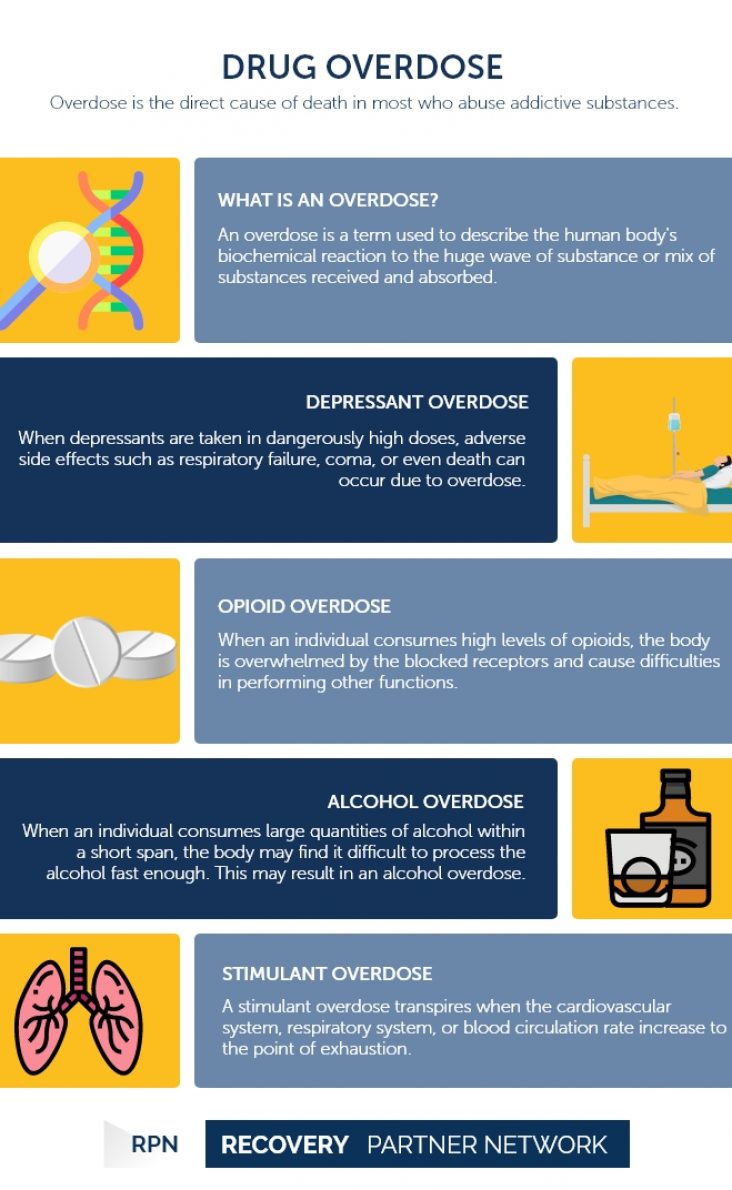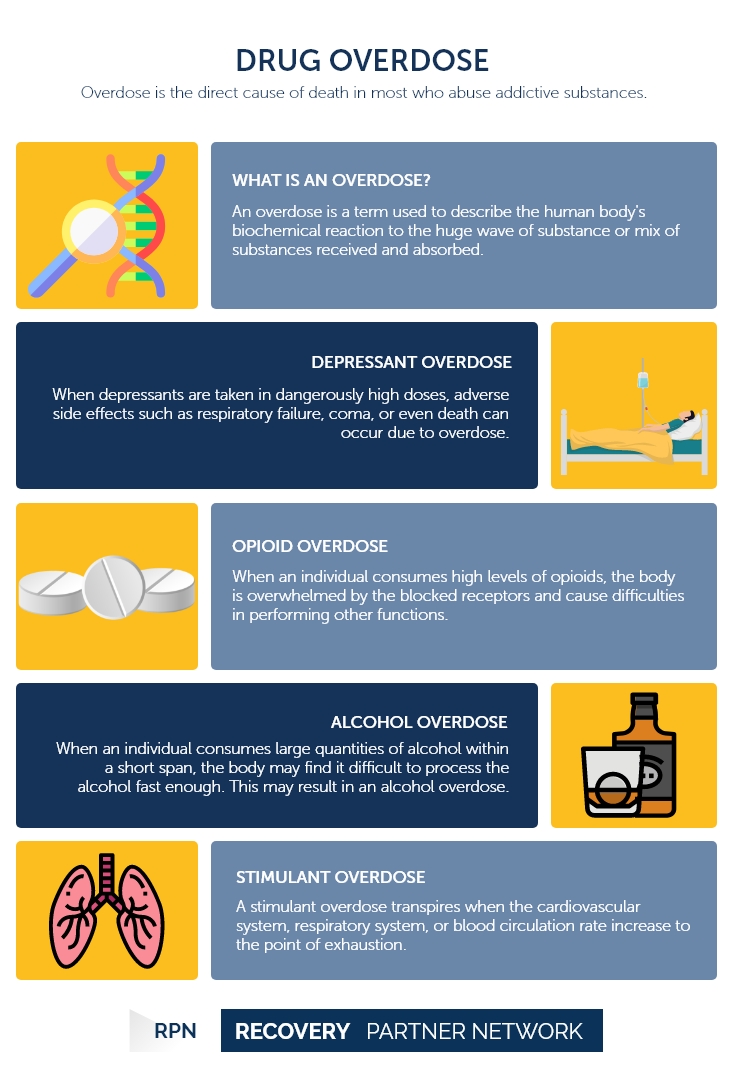Overdose is the direct cause of death in most who abuse addictive substances.
Drug Overdose
Drug overdose | Table of Contents
What is an Overdose?
An overdose is a term used to describe the biochemical reaction of the human body to the huge wave of substance or mix of substances received and absorbed. An overdose can be deliberate or accidental, and people can overdose on illegal drugs, alcohol, prescription medications, and many other substances.
Overdoses are fatal in most cases, but most who experience an overdose can be revived with prompt medical attention. Although various drugs can overwhelm the body in different ways, respiratory failure stands to be the most common cause of death in the event of any chemical overdose.
FAQ
- How often do people overdose?
- What types of drugs can cause an overdose?
- Are drug overdoses always accidental?
Overdoses are quite common among people who take drugs. The number of drug overdose deaths went up 23% from 2010 to 2014. The addictive nature of drugs easily leads to potential overdoses.
Most drug overdose cases are accidental, but some individuals are known to take high doses during suicide attempts.
Depressant Overdose
Depressants are drugs that influence the central nervous system (CNS), such as opioids, benzodiazepines, and alcohol. CNS depressants reduce blood pressure and body temperature and slow down the heart rate and breathing, resulting in sedation, diminished anxiety, and enhanced calmness and euphoric highs. Thus, when depressants are taken in dangerously high doses, adverse side effects such as respiratory failure, coma, or even death can occur due to overdose.
Opioid Overdose
Opioids are regarded as one of the easiest drugs to overdose on, considering its function when consumed. When an individual consumes an opioid, the opioid receptors located in various areas of the body, including the brain, central nervous system, and gastrointestinal tract, activate and slow down the body. When the body is overwhelmed with opioids, these receptors get blocked and find it difficult to perform other functions. This leads to a higher risk of an overdose, which may slow down the user’s breathing to the point of failure.
Certain opioids can be more or less severe than others. While it may take a few minutes for individuals who consume heroin to encounter an overdose, individuals who consume fentanyl may experience it in a matter of seconds. Such strong opioids were the prime cause of the national opioid epidemic in 2017.
What is Naloxone?
Popularly marketed under the brand name of Narcan, naloxone is an opioid agonist that inhibits the effects of opioids in the body. When an individual faces an opioid overdose, administering one or two doses of Narcan, depending on the severity of the overdose, will potentially stop the condition from worsening and save their life. Narcan is generally available throughout the country without a prescription.
Alcohol Overdose
An alcohol overdose occurs when an individual consumes more alcohol than what the body can process safely. The body can generally metabolize about one unit of pure alcohol per hour (estimated to be the volume of alcohol in a small shot of liquor, half a pint of beer, or one-third of a glass of wine). Thus, when an individual consumes more alcohol than this within a short span, the body may find it difficult to process the alcohol fast enough, causing the excess alcohol to keep circulating in the body. This may result in an alcohol overdose, also known as alcohol poisoning.
Some of the risks of alcohol poisoning are:
- Seizures
- Mental confusion
- Slow breathing (fewer than eight breaths per minute)
- Irregular breathing (a gap of 10 seconds or more between breaths)
- Vomiting
- Hypothermia
- A decrease in heart rate
Some of the risk factors that influence the likelihood of having an alcohol overdose are:
- Age
- Gender
- Body mass/size
- Tolerance
- Binge drinking
- Drug use
- Other underlying health conditions
Stimulant Overdose
Stimulants, such as meth and cocaine, operate on the CNS in a unique way in comparison to opioids by raising heart rate, blood pressure, body temperature, and breathing. Thus, a stimulant overdose transpires when the cardiovascular system, respiratory system, or blood circulation rate increase to the point of exhaustion.
Some of the symptoms of a stimulant overdose are:
- Twitching or rigid limbs
- Seizures
- Rapidly increasing body temperature
- Rapidly increasing pulse
- Chest pain
- Loss of consciousness or episodes of blackouts
- Pounding headaches
- Profuse sweating
- Irritability or agitation
- Disorientation
- Severe hypertension
- Delirium
- Stroke
- Cardiac arrest
- Cardiovascular collapse
- Abnormal or shallow breathing
Currently, there are no FDA sanctioned treatments for a stimulant overdose. However, there are a few medications available to reduce or stabilize the elevated vital symptoms, such as pulse, body temperature, blood pressure, and any respiratory irregularities. Certain anti-epileptic drugs are also available to manage an individual experiencing seizures or convulsions during an overdose.
Overdose Statistics
- Around 63,600 deaths in 2016 were attributed to drug overdoses.
- An average of 130 individuals experiences a fatal opioid overdose each day.
Overdose is a horrifying term that is often related to death. However, overdose and death do not always go hand in hand if proper treatment is acquired in time. The development of drug tolerance and polydrug abuse is generally the main cause of an overdose in many individuals. Hence it is vital that individuals who abuse drugs and alcohol seek treatment for their addiction to avoid such severe consequences.
FAQ
- Who is most at risk of an overdose?
- What does a drug overdose look like?
- How to help a person who is overdosing?
- What treatments do medical professionals use to treat overdose?
- What kind of follow up care is needed after an overdose?
- How does damaged liver effect overdose?
- What are the risk factors for an overdose?
- What are the signs of an overdose?
People who are relatively new to drug use and those who relapse after prolonged sobriety are generally most at risk of an overdose.
The symptoms of a drug overdose can fluctuate dramatically depending on the type of drug taken. For instance, individuals who overdose on stimulant drugs might experience symptoms similar to a heart attack.
Individuals who are suffering an overdose require urgent medical attention. Call 911 and wait with the person until the paramedics arrive.
Naloxone is given as a treatment to counteract the effects of opiate drugs such as heroin. Stomach lavage is also used as a form of overdose treatment if the patient has not injected or snorted the drugs. An individual who is violent or agitated could benefit from a sedative so they would not hurt themselves or anyone around them.
Patients who overdose are hospitalized for a few days to keep them from using the drugs. They are later moved from the inpatient overdose care program to a detoxification program.
A damaged liver can cause longer and more frequent overdoses.
Some individuals are at greater risk of undergoing an overdose than others. Risk factors related to overdose include poly-drug use (mixing drugs), past overdoses, using drugs alone, age, or heroin use.
Some overdose signs include slow or shallow breathing, inability to wake up or respond, blue-gray lips and fingernails, and pale skin.
Recovery Partner Network
We aim to educate and empower. If you feel our library of resources does not cover your specific need, reach out to us, and we would be happy to help.
STATISTICS
© Copyright 2025


